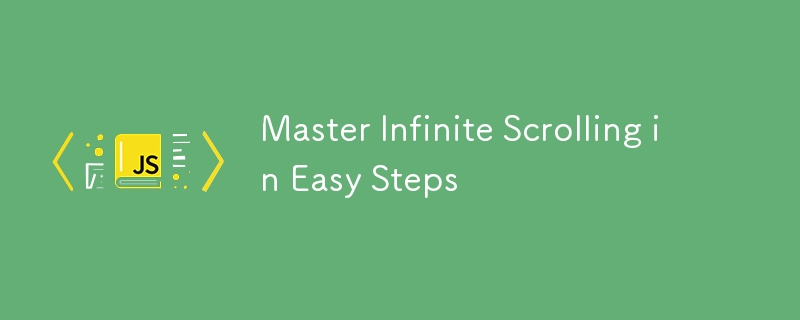通过简单的步骤掌握无限滚动
- WBOYWBOYWBOYWBOYWBOYWBOYWBOYWBOYWBOYWBOYWBOYWBOYWB原创
- 2024-08-18 07:04:351167浏览

无限滚动
我们可以使用浏览器提供的 IntersectionObserver API 来实现无限滚动。
要实施,我们只需按照以下步骤操作:-
- 我们可以使用模拟 API 进行无限滚动,然后创建自定义钩子
- 这个自定义钩子将API的参数作为其自己的函数参数。
- 然后我们就可以简单的实现API调用了,使用useEffect和axios,传入函数参数中的参数。
- 我们可以将 loading、error、hasMore 和 data 作为状态
- 然后我们还可以使用 setTimeout 以便我们可以正确检查加载以及无限滚动
- hasMore 将等于我们当前在页面中显示的数据数组的长度与我们从 api 调用获取的数据相比
- 这有更多的功能,可以避免调用,即使我们到达数据末尾。
- 一旦自定义钩子出现在我们的主页中,我们将创建我们传递的参数的状态
- 然后我们将参数传递给我们的自定义钩子并检索数据
- 我们得到的数据列表,我们将使用地图渲染它,然后显示它
- 现在,一旦到达末尾,我们就需要应用无限滚动,因此对于我们收到的数组的最后一个元素数据,我们只需添加一个引用
- 此引用相当于 useCallback 函数,其参数将是最后一个元素。
- 接下来我们将创建一个useRef,其值默认为null
- 现在我们将检查是否处于加载状态。如果是,我们将直接返回
- 接下来我们将检查这个 useRef 当前值是否为 null。如果不为空,我们将简单地断开该观察者的连接。这里的想法是观察者每次都应该是新的,因为每次我们都会有新的数据
- 现在我们将通过新的 IntersectionObserver 分配这个新的观察者。回调函数的当前值。IntersectionObserver API 将返回一个回调函数,以条目作为参数。
- 这些条目基本上是页面中最后一个元素的值。我们想要与页面中的这些条目交互时的条件
- 所以我们为每个条目都有一个布尔值。相交
- 当这是真的时,我们将使自定义钩子的参数发生变化。这将再次调用 api 并再次渲染
- 最后我们需要观察我们在回调中传递的元素,因此如果我们有该元素,我们将简单地观察它。
代码
CustomHook.jsx
import axios from "axios";
import { useEffect, useState } from "react";
import { API_URL } from "../common/constants";
export const useAuthorList = (limit, page) => {
const [isLoading, setIsLoading] = useState(false);
const [authorList, setAuthorList] = useState([]);
const [error, setError] = useState("");
const [hasMore, setHasMore] = useState(true);
useEffect(() => {
setIsLoading(true);
setTimeout(() => {
axios({
method: "GET",
url: API_URL,
params: { limit: limit, page: page },
})
.then((res) => {
setAuthorList(res.data.data);
setHasMore(res.data.data.length === limit);
setIsLoading(false);
})
.catch((e) => setError(e));
}, 500);
}, [limit, page]);
return [isLoading, authorList, error, hasMore];
};
App.jsx
import React, { useCallback, useRef, useState } from "react";
import { useAuthorList } from "./hooks/useAuthorList";
import { AuthorQuotes } from "./components/AuthorQuotes";
const App = () => {
const [limit, setLimit] = useState(10);
const [page, setPage] = useState(1);
const [isLoading, authorList, error, hasMore] = useAuthorList(limit, page);
const observer = useRef(null);
const infiniteReference = useCallback(
(element) => {
if (isLoading) return;
if (observer.current) {
observer.current.disconnect();
}
observer.current = new IntersectionObserver((entries) => {
if (entries[0].isIntersecting && hasMore) {
setLimit((prev) => prev + 10);
}
});
if (element) {
observer.current.observe(element);
}
},
[isLoading, hasMore]
);
return (
<div className="author-quotes-list">
{authorList.length > 0 &&
authorList.map((authorQuotes, index) => {
if (index + 1 === authorList.length) {
return (
<AuthorQuotes
authorQuotes={authorQuotes}
hasReference
infiniteReference={infiniteReference}
/>
);
}
return <AuthorQuotes authorQuotes={authorQuotes} />;
})}
{isLoading && <>Loading...</>}
</div>
);
};
export default App;
constants.js
export const API_URL = "https://api.javascripttutorial.net/v1/quotes/"
以上是通过简单的步骤掌握无限滚动的详细内容。更多信息请关注PHP中文网其他相关文章!
声明:
本文内容由网友自发贡献,版权归原作者所有,本站不承担相应法律责任。如您发现有涉嫌抄袭侵权的内容,请联系admin@php.cn

